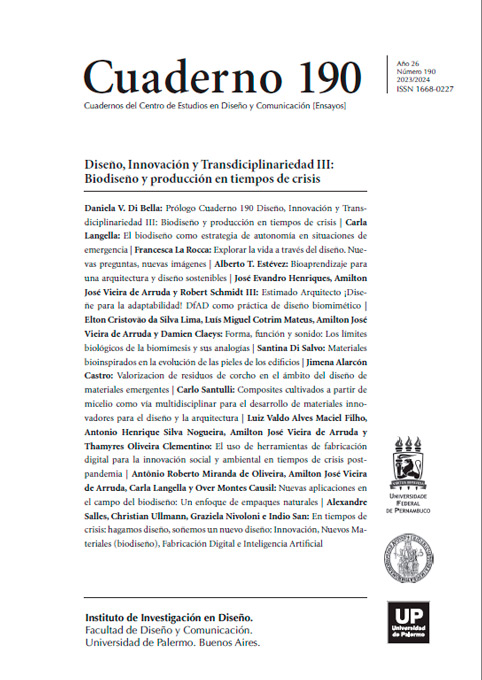Valorización de residuos de corcho en el ámbito del diseño de materiales emergentes
Abstract
The manuscript stems from the experimentation carried out to design materials with a sustainable approach based on the use of cork waste in the form of cork stoppers from household packaging.
References
Alarcón, J., Rognoli, V., & Llorens, A. (2020). Diseñar para un escenario social incierto. El valor del enfoque materiales Do-It-Yourself y economía circular. Interciencia, 45(6), 279-285.
Alarcón, J., Westermeyer, J., Di Bartolo, C., & Castillo, C. D. (2015). Valorización de cuero de vacuno residual de manufactura de calzado, como estrategia sustentable para elaboración de tableros De Pinus radiata EN Bío-Bío, Chile. Interciencia, 40(2), 138-144.
Ashby, M. F. (2012). Materials and the environment: eco-informed material choice. Elsevier.
Ashby, M. F. (2016). Chapter 1—Background: Materials, Energy and Sustainability. Materials and Sustainable Development; Ashby, MF, Ed.; Butterworth-Heinemann: Boston, MA, USA, 1-25.
Barati, B., Karana, E., & Hekkert, P. (2019). Prototyping materials experience: Towards a shared understanding of underdeveloped smart material composites. International Journal of Design, 13(2), 21-38.
Beylerian, G. M., Dent, A., & Quinn, B. (2008). Ultramateriales: formas en que la innovación en los materiales cambia el mundo. Blume.
Bergström, J., Clark, B., Frigo, A., Mazé, R., Redström, J., & Vallgårda, A. (2010). Becoming materials: material forms and forms of practice. Digital Creativity, 21(3), 155-172.
Blanpain, B., Meskers, C. E., Olivetti, E., Apelian, D., Howarter, J., Kvithyld, A., & Spangenberger, J. S. (2016). REWAS 2016: Towards materials resource sustainability. John Wiley & Sons.
Costa, C., Viana, A., Silva, C., Marques, E. F., & Azoia, N. G. (2022). Recycling of textile wastes, by acid hydrolysis, intonew cellulosic raw materials. Waste Management, 153, 99-109.https://doi.org/10.1016/j.wasman.2022.08.019
Ceschin F., & Gaziulusoy, I. (2016). Evolution of design forsustainability: From product design to design for systeminnovations and transitions. Design studies, 47: 118-163. https://doi.org/10.1016/j.destud.2016.09.002
Fernandes, E. M., Correlo, V. M., Chagas, J. A., Mano, J. F., & Reis, R. L. (2011). Properties of new cork–polymer composites: advantages and drawbacks as compared with commercially available fibreboard materials. Composite structures, 93(12), 3120-3129.
Giaccardi, E., & Karana, E. (2015). Foundations of materials experience: An approach for HCI. In Proceedings of the 33rd Annual ACM Conference on Human Factors in Computing Systems (pp. 2447-2456).Gil, L. (2015). New cork-based materials and applications. Materials, 8(2), 625-637.
Happaerts, S. (2014). International Discourses and Practices of Sustainable Materials Management, Policy Research Centre for Sustainable Materials Management, Report number: n° 5, Leuven. 12-13 pp.
Karana, E., Nimkulrat, N., Giaccardi, E., Niedderer, K., & Fan, J. N. (2019). Alive. Active. Adaptive: Experiential knowledge and emerging materials. International Journal of Design, 13(2), 1-5.
Karana, E., Barati, B., Rognoli, V., & Zeeuw Van Der Laan, A. (2015). Material driven design (MDD): A method to design for material experiences. International journal of design, 9(2), 35-54.
López, Y. M., González, M. G., & Rodríguez, E. M. (2014). Impacto ambiental de residuos industriales de aserrín y plástico. Usos para la industria de tablero en Cuba. Avances, 16(2), 91-99.
Mestre, A. (2015). A design action intervention approach in the cork industry towards sustainable product innovation. Journal of Design Research, 13(2), 185-235.
Mestre, A., & Vogtlander, J. (2013). Eco-efficient value creation of cork products: an LCA-based method for design intervention. Journal of Cleaner Production, 57, 101-114.
Parisi, S., Rognoli, V., & Sonneveld, M. (2017) Material Tinkering. An inspirational approach for experiential learning and envisioning in product design education. The Design Journal, 20(sup1), S1167-S1184. https://doi.org/10.1080/14606925.2017.1353059
Pedgley, O., Rognoli, V., & Karana, E. (2021). Expanding territories of materials and design. In Materials Experience 2 (pp. 1-12). Butterworth-Heinemann.
Pintor, A. M., Silvestre-Albero, A. M., Ferreira, C. I., Pereira, J. P., Vilar, V. J., Botelho, C. M., ... & Boaventura, R. A. (2013). Textural and surface characterization of cork-based sorbents for the removal of oil from water. Industrial & Engineering Chemistry Research, 52(46), 16427-16435.
Sauerwein, M., Karana, E., & Rognoli, V. (2017). Revived beauty: research into aesthetic appreciation of materials to valorise materials from waste. Sustainability, 9(4), 529.
Sierra-Pérez, J., López-Forniés, I., Boschmonart-Rives, J., & Gabarrell, X. (2016). Introducing eco-ideation and creativity techniques to increase and diversify the applications of eco-materials: The case of cork in the building sector. Journal of cleaner production, 137, 606-616.
Smol, M., Kulczycka, J., & Avdiushchenko, A. (2017). Circular economy indicators in relation to eco-innovation in European regions. Clean Technologies and Environmental Policy, 19, 669-678.
Technische Universiteit Delft. (2013). Final Report Summary - LIGHT.TOUCH.MATTERS (Design driven development of touch sensitive luminous flexible plastics for applications in care & well-being). Recuperado el 30 de enero de 2023 de https://cordis.europa.eu/project/id/310311/reporting
Yoon, J., Kim, C., & Yoon, J. (2020). Positive user experience over product usage life cycle and the influence of demographic factors.
Los autores/as que publiquen en esta revista ceden los derechos de autor y de publicación a "Cuadernos del Centro de Estudios de Diseño y Comunicación", Aceptando el registro de su trabajo bajo una licencia de atribución de Creative Commons, que permite a terceros utilizar lo publicado siempre que de el crédito pertinente a los autores y a esta revista.


